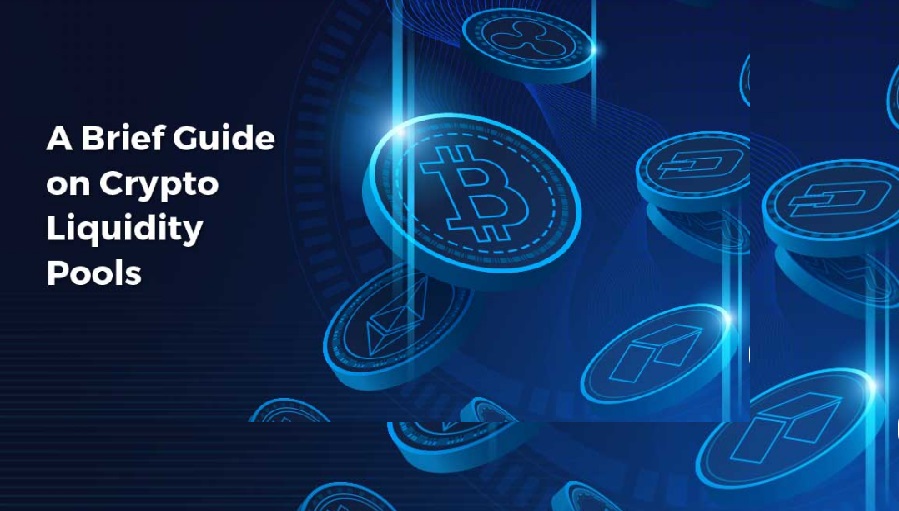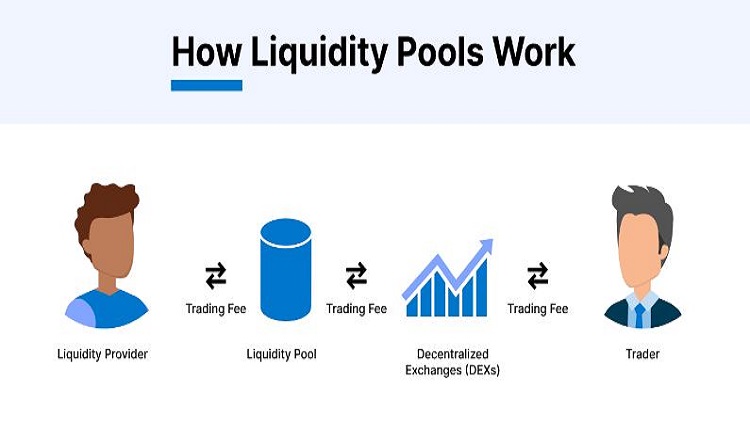The following article about the top Liquidity pool providers will help you gain an in-depth understanding of liquidity pools. Covering everything from trading choices to steps of investing in liquidity pools and leading liquidity pool providers.

Contents
What is a Crypto Liquidity Pool?
A liquidity pool is like a digital store of cryptocurrency locked in a smart contract. This makes transactions faster and easier.
Automated Market Makers (AMMs) are a key factor in liquidity pools. AMMs are like protocols that use the pool to allow digital assets to trade automatically without regular buyers and sellers.
In other words, when people use an AMM platform, they give tokens to the liquidity pools. The AMM uses a mathematical formula to determine the price of these tokens in the pool.
Formula: X*Y= K
Liquidity pools are also important for things like yield farming and online games on the blockchain.
These pools aim to attract individuals from various crypto platforms, called liquidity providers (LPs), to participate.
After that, LPs receive rewards, including a portion of fees and bonuses, determined by the amount of liquidity they contribute. These rewards are liquidity provider tokens (LPTs).
How does Crypto Liquidity Work in Crypto?
Liquidity pools make it possible for people to buy and sell cryptocurrencies on a decentralized exchange (DEX) without needing a central order book or a traditional market maker. Instead, a smart contract manages all the trading.
In the contract, automated market maker (AMM) algorithms figure out the token prices and change them based on how many people want to buy or sell. However, this ensures that the tokens in the pool always stay in balance.

Investors who put their tokens in the pool get a part of the fees from the exchange or some other rewards. The more tokens you add, the bigger your share of the reward.
How to Invest in Liquidity Pools?
By depositing the crypto into a liquidity pool, anyone can become a liquidity provider and earn trading fees according to their share of the pool.
Here are the steps to investing in a liquidity pool:
1. First, Select a cryptocurrency exchange or DeFi platform that supports liquidity pools.
2. Sign up for an account or access your DeFi portfolio on your chosen platform.
3. After that, connect your wallet (Metamask, Uniswap wallet, or Coinbase wallet) and confirm the wallet connection.
4. Then, click on the “Pools” tab and select any liquidity pool to check the historical performance and asset description.
5. Choose the currency you want to use and enter the amount you want to invest in the liquidity pool.
6. Then, Confirm the transaction in your wallet.
7. After successfully depositing your asset. Now, you can check your pool shares on the portfolio page. By clicking on the asset, you can check your Profit/Loss, Return, and the Fees you have paid.
Top Liquidity Pool Providers List
Let’s explore some of the top liquidity pool providers.
1. Uniswap
Uniswap stands out as a top choice on the liquidity pools list because of its high trading volume. This decentralized exchange pairs Ethereum with ERC-20 tokens at a 1:1 ratio, enabling decentralized trading between ETH and any ERC-20 token.
Uniswap’s open-source nature is a key advantage. It allows anyone to create new liquidity pools for different cryptocurrencies without charging any fees.
Just like with other liquidity pool providers, when you put your cryptocurrency into Uniswap to supply liquidity, you get Uniswap tokens in return. For example, if you deposit DAI, you’ll get an equal amount of Uniswap tokens.
2. Balancer
The balancer is an Ethereum-based system that does three things: manages portfolios, provides liquidity, and keeps an eye on prices. You can use it to create your own customizable pools or add money to existing ones and make some money from trading fees.
Moving on to its pool types, Balancer has a few different types of pools. Private ones are under the full control of the owner. In shared pools, everything is already set, like the rules, tokens, and fees.
There’s no special treatment here – anyone can add money, and ownership is tracked with Balancer Pool Tokens. Smart pools are like private pools, but smart contracts control them. They accept money from anywhere and are tracked using the Balancer Pool Token.
In April 2020, they introduced a governance token called BAL, which they gave out to liquidity providers through something called liquidity mining.
Furthermore, Balancer has many different pools, like DIA/USDC, USDC/BAL, and NMR/WETH.
3. Curve Finance
Curve is an Ethereum-based platform where investors can trade stablecoins in a decentralized liquidity pool.
It offers low price fluctuations because stablecoins don’t jump around a lot. The curve may introduce its own token called CRV in the future.
There are 7 different pools on the platform, and each pool has its own pair of tokens. You can swap between various stablecoins and assets in pools like Compound, PAX, Y, BUSD, sUSD, Ren, and sBTC.
4. Convexity Protocol
Convexity is like a place where you can provide and trade in a pool of different tokens. They have something called “otokens,” which are like special contracts you can create and sell to others. This can be helpful for beginners and those who want to play it safe.
However, one useful feature is providing insurance for your investments, making it a safer choice for new traders and liquidity providers.
5. Bancor
Bancor is an Ethereum-based protocol that works with pooled liquidity, like Curve, Uniswap, and others. It uses “Smart Tokens” to make sure there’s enough money to trade and to keep prices accurate.
These Smart Tokens are connected to other tokens like ETH and change their supply to keep the ratio fixed.
In Bancor, they have something called the Bancor relay, which helps with stablecoins. It deals with the issue of prices changing too much because of the BNT token, their own currency. With Bancor, you can mix BNT, Ethereum, or EOS tokens, and their stablecoin (USDB) in one pool.
BNT is used to swap between different blockchains like Ethereum and EOS. Bancor doesn’t have a fixed swapping fee like Uniswap; instead, it can vary from 0.1% to 0.5% depending on the pool.
6. DeversiFi
DeversiFi is a really fast crypto liquidity pool. This decentralized exchange can process a lot of transactions quickly, up to 9000 per second. It does this by using a special technology called layer 2 scaling.
DeversiFi has some cool features. It lets you pool your money with others for more liquidity, and it has very low fees because of its fast transactions.
To use DeversiFi, you can deposit your cryptocurrency from both public and private wallets into their special smart contract. This smart contract can handle transactions off the main blockchain while keeping track of your balance on the blockchain. The native token, NEC, is used for all these actions.
7. ICTE
One special thing about ICTE is that it allows you to trade between different exchanges. They use a DeFi protocol to link up exchanges from various places that work on different blockchains.
The main goal is to solve problems related to safety, keeping your assets, and delays. At the same time, ICTE makes sure there’s enough money for everyone using the platform. Each exchange on ICTE works by itself, but they are all part of a big worldwide system called the ICTE Alpha server.
8. Kyber Network
Kyber is a system on Ethereum that helps DApps make things better for users. This means that vendors and wallets can let users do more things like paying, swapping, and getting different tokens all in one go.
They also have their own token called KNC. Investors who own and use KNC can help make decisions about the system and get rewarded for it. You earn rewards by staking your KNC and following the rules in the smart contract.
9. OIN Finance
OIN Finance is a fascinating new liquidity pool. It’s the first DeFi project on the Ontology Blockchain. Even though it hasn’t been launched yet, it’s expected to provide different DeFi services like OINwap, wallets, lending, stablecoins, and a DAO.
If you have their utility token, you can put your money into the pool and earn rewards following the rules in the smart contracts. OIN Finance team recently collected nearly $1 million in a private deal and just two days after that, the team began preparing for a public sale.
10. KeeperDao
KeeperDAO is like an on-chain DeFi insurance system on Ethereum. It encourages people to join in and manage liquidation effectively. It also moves things around in margin trading, exchanges, and lending.
When you put your money in KeeperDAO’s pool, they take a small fee of 0.64% from the assets you add. They have five different pools where you can earn ROOK tokens. KeeperDAO uses the money from these pools to make quick loans.
FAQs
A good crypto liquidity provider needs to make sure there are enough trades happening to keep the market running smoothly.
They should also have many different markets and places to trade. If one place is running slow on trades, it should be able to move trades from one market to another to keep things going.
This is when a trader earns the most money from fees inside a pool. When a crypto liquidity provider makes trades within a liquidity pool, they get a fee for their part. If they swap or sell crypto in a pool with rewards, they can get even more crypto in return.
Putting your cryptocurrency into a liquidity pool has its dangers. The main concerns are connected to DApp developers, smart contracts, and market ups and downs. DApp creators could take your assets or waste them.
Smart contracts could have problems or vulnerabilities that can freeze or let someone steal your funds.
Final Words
The rise of crypto liquidity pools is good for the overall growth of crypto and DeFi. These pools make it faster to do crypto transactions because you don’t have to wait for someone to match your order.
They use smart contracts, which are like computer programs, to create the best pools for what you need.
Besides helping with crypto market problems, liquidity pools also make it easier for more people to use crypto and DeFi. New traders and people who provide liquidity can use these pools to feel safer when trading cryptocurrency. However, it’s important to understand how each liquidity pool works before you decide to use it.